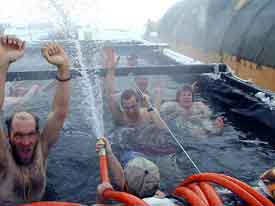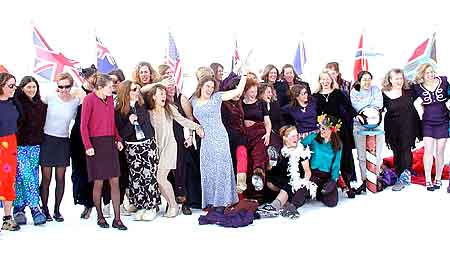|
|
 |
Like all visitors to the South Pole, Chuck
McParland's first scheduled stop upon arriving in Christchurch after more
than five days en route was a visit to the CDC. "I told the cabbie I
was kind of surprised that New Zealand needed its own Center for Disease
Control. Turns out CDC stands for 'Clothing Distribution Center.'"
The National Science Foundation makes sure everyone who goes to the
pole dresses warmly by issuing thick long johns, heavy down parka, snow
pants, goggles, boots, liners, socks, cap, and up to a dozen pairs of
gloves. McParland left the place with two stuffed duffle bags, one full of
clothes he had to wear on the flight.
The trip from Christchurch involves two legs, the first a noisy
eight-hour flight to McMurdo Sound in an Air Force Reserve C-130 cargo jet
chock full of equipment and supplies, followed the next day by a
three-hour trip to the Amundsen-Scott South Pole Station.
On the shorter second leg, even though the round trip requires less
than half the C-130's fuel capacity, its tanks are filled to the brim.
After the ski-equipped jet slithers to a stop, the excess fuel is
off-loaded at the station, where the kerosene-like JP-8 is used to run
everything from the kitchen stove to space heaters to AMANDA's hot-water
drills. The only thing that doesn't need imported energy is the deep
freeze -- crates of frozen food are simply left outside the heated areas
under the dome.
 |

AN EXHILARATING OUTDOOR BATH AT THE SOUTH POLE
|
Bob Stokstad discovered that an ancillary use for the heated drilling
water is in the open-air holding tanks used as hot tubs by South Pole
denizens who like to freeze from the chin up while poaching from the neck
down. Since most work and private time is spent inside temporary
Quonset-hut-shaped padded tents known as Jamesways or in other cramped
spaces, outdoor diversions are prized.
Stokstad reports that one popular event is the Race Around the World.
"It's three times around the pole. To win a T-shirt all you have to
do is finish -- on foot, skis, bicycles, sleds, whatever."
The race and the millennium New Year's Party that allowed participants
to celebrate 24 midnights in a row were welcome breaks in a schedule that
otherwise involved long hours of work under extreme conditions.
Remoteness is a fact of life, says Chuck McParland, when even Internet
access, via satellite, is limited to a few hours a day. "You're
really at the end of a long, thin string. Any connection to the outside
world requires a big effort."

A GROUP PHOTO OF THE WOMEN ON THE OCCASION OF NEW YEAR'S EVE AT THE
AMUNDSEN-SCOTT SOUTH POLE STATION
Additional information:
|


